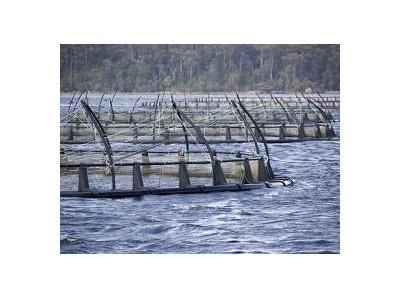The Importance of Biomass: Introducing Ace Aquatecs 3D Biomass Camera

The latest technology in aquaculture has progressed significantly over the last 50 to 100 years, leading to advances such as more accurate observations, analysis and environmental monitoring. A lack of precision in measurements and accounting of fish numbers, average weights and size distribution, is costly for the aquaculture industry, but a new product from Scottish firm Ace Aquatec could offer a solution. Bonnie Waycott spoke to company director Nathan Pyne-Carter to learn more about the firm's new 3D biomass camera, which is designed to provide accurate, real time biomass readings.
After 5 years of development following receipt of a Scottish Feasibility Award in 2011, Ace Aquatec's new 3D biomass camera was unveiled at Aquaculture UK in Aviemore, Scotland, this May. The camera was developed by a specialist team of flight camera engineers, as well as consultants with a long history of working with novel biomass camera systems. UK fish farms such as Loch Duart were also involved, for example in refining the necessary software.
"The camera provides a genuine 3D image of fish, rather than overlaying two 2D images to create a pseudo 3D image," explained Mr Pyne-Carter.
"This makes our system extremely accurate. Current systems rely on fish swimming through a frame, which can skew biomass data. The 3D camera, however, can take continuous footage of fish and then separate individuals from the shoal."
Biomass estimation is usually achieved through experience-based knowledge and measurements using different instruments and/or manual weight sampling, and depends on knowledge on the number of fish in the cage or pen and their average weight. However, inaccurate counting can lead to incorrect data or increased production costs, while excessive handling can induce mortality, slow growth or cause illness.
By taking huge quantities of accurate images, Ace Aquatec's 3D biomass camera is able to offer complete and regular biomass readings of the growth of individuals within the cage. A fixed IP68 computer records and processes the data, while wifi or a handheld rugged tablet allows quick assessments to be made on site, as farmers can access the data in real time, charting the growth of fish as they approach harvest weight, and provide indications of parasites or diseases in the cage, which impact weight gain. The data can also improve the efficiency of fish feed, saving money on wasted feed.
"The camera can be used in any underwater application where time of flight 3D images may be of interest," said Mr Pyne-Carter. "For biomass, it can be used at sea, or on land-based farms."
3D images are created with a pulsed green light, while depth readings are used to measure a given pixel's distance from the camera. Time of flight technology has used infra red, which works well with the silicone time of flight chipsets, but one challenge, explained Mr Pyne-Carter, was creating a green light version that travels far enough underwater to provide accurate measurements with high enough resolution.
"The switching speed of LEDs was a difficulty we overcame in the project to create the desired resolution, as was the green light sensor," said Mr Pyne-Carter.
"But thanks to excellent engineers working with us, we were able to address any difficulties."
Now in its final stages of testing at local Scottish fish farms, the 3D biomass camera will be released in the coming months, after which it will be available to rent to all Scottish salmon farms and for sale to salmon farming regions internationally.
Quotations will be calculated depending on the number of fixed or movable systems required by each cage, and whether access to Ace Aquatec's online portal is necessary. It is hoped that this new product will play a key role in offering information on feeding regimes, harvest rates, growth rates, disease or lice, and access to data on fish health.
3D biomass camera systems are not the only area Ace Aquatec is involved in. The firm makes a range of mid and low frequency seal and sea lion deterrents to reduce fish mortalities on fish farms, and also provides the only electric net on the market, which creates conditioned aversive avoidance behaviour from fish farms, another way of deterring seals, sea lions and sharks.
The company also makes humane electric stunners for a range of commercial fish species worldwide, with salmon machines supplied to Norway stunning up to 75 tonnes per hour using electricity. These are the only systems available on the market that can stun a wide variety of commercial species, including wild fish, with a guaranteed 100 per cent stun. The company is also looking forward to the release of a new sea lice machine next year.
Bonnie Waycott, Freelance journalist based in Tokyo. Bonnie became interested in marine life when she learned how to snorkel on the Sea of Japan coast near her mother's hometown. With a keen interest in marine conservation, fish farming and sustainable oceans, she's a freelance writer who covers diving and marine-related issues in Japan and is currently taking an MSc in Sustainable Aquaculture.
Có thể bạn quan tâm
 Brazil Must Increase its Shrimp Exports, says Minister
Brazil Must Increase its Shrimp Exports, says Minister BRAZIL - Brazil needs to increase its shrimp exports, said the minister of Agriculture, Livestock and Supply during his visit to shrimp farming areas in Aracati
 Aquaculture Task Force Launched in Kochi
Aquaculture Task Force Launched in Kochi INDIA - The Krishi Vigyan Kendra (KVK), attached to the Central Marine Fisheries Research Institute (CMFRI), has launched an Aqua Task Force to help boost fish
 AquaSmart to Hold Aquaculture Data Analytics Workshop in Dublin
AquaSmart to Hold Aquaculture Data Analytics Workshop in Dublin IRELAND - Following the recent successful presentations at the 5th Annual World Congress of Aquaculture and Fisheries in China and the Aquaculture Summit